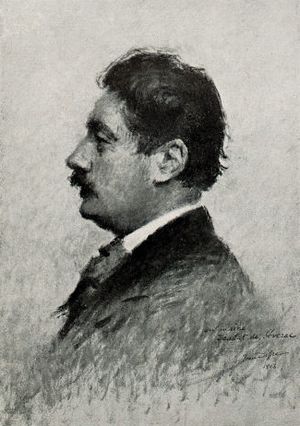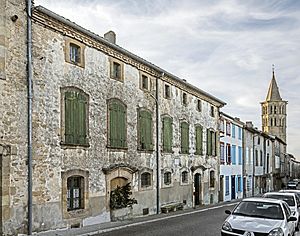Déodat de Séverac facts for kids
Marie-Joseph Alexandre Déodat de Séverac (pronounced "Day-oh-DAH duh Say-veh-RAHK") was a French composer. He was born on July 20, 1872, and passed away on March 24, 1921.
Contents
His Life Story
Séverac was born in a town called Saint-Félix-de-Caraman in France. He came from a noble family that was deeply connected to the musical traditions of their home region, Languedoc.
He first studied music in Toulouse. Later, he moved to Paris to continue his studies at the Schola Cantorum. This was a different kind of music school compared to the main Conservatoire de Paris. At the Schola Cantorum, he learned to play the organ and also worked as an assistant to another famous musician, Isaac Albéniz.
After his studies, Séverac returned to the southern part of France. He spent most of his life there. This area was special because many artists and poets he had met in Paris were also drawn to it. One of his operas, Héliogabale, was performed in Béziers in 1910.
Déodat de Séverac died in Céret, France, when he was 48 years old.
His Music
Séverac is well-known for his vocal and choral music. This means he wrote many songs for singers and choirs. He often used words from the Occitan language (the old language of Languedoc) and the Catalan language (from Roussillon). He also set French poems by famous writers like Verlaine and Baudelaire to music.
He also wrote many pieces for solo piano. Many of these piano works were given titles that sounded like pictures or scenes. They were published in collections such as Chant de la terre, En Languedoc, and En vacances.
A popular example of his piano music is "The Old Musical Box" (its full title is "Où l'on entend une vieille boîte à musique"). However, his most famous piano work is the suite called Cerdaña. He wrote it between 1904 and 1911. This piece is full of the unique sounds and colors of the Languedoc region. His church song, a motet called Tantum ergo, is still used in churches today.
Types of Music He Wrote
Déodat de Séverac wrote many different kinds of music. Here are some of the main types:
Operas
He wrote several operas, which are plays set to music. Some of his operas include:
- Le Cœur du moulin (1908)
- Héliogabale (1910)
Works for Piano
He composed many pieces for the piano, both for one player and for two. Some well-known ones are:
- Le Chant de la terre (1900)
- En Languedoc (1904)
- Cerdaña. 5 Études pittoresques (1904–1911)
- En vacances. Petites pièces romantiques (1912)
- Où l'on entend une vieille boîte à musique (An Old Music Box)
Chamber Music
Chamber music is written for a small group of instruments. Séverac wrote pieces for instruments like the flute, violin, cello, and piano.
Choral Music
He also wrote music for choirs to sing. Some of his choral works include:
- Sant Félix (1900)
- Sainte Jeanne de Lorraine (1913)
Songs
Séverac composed many art songs, which are songs for a solo singer with piano accompaniment.
Images for kids
See also
 In Spanish: Déodat de Séverac para niños
In Spanish: Déodat de Séverac para niños






